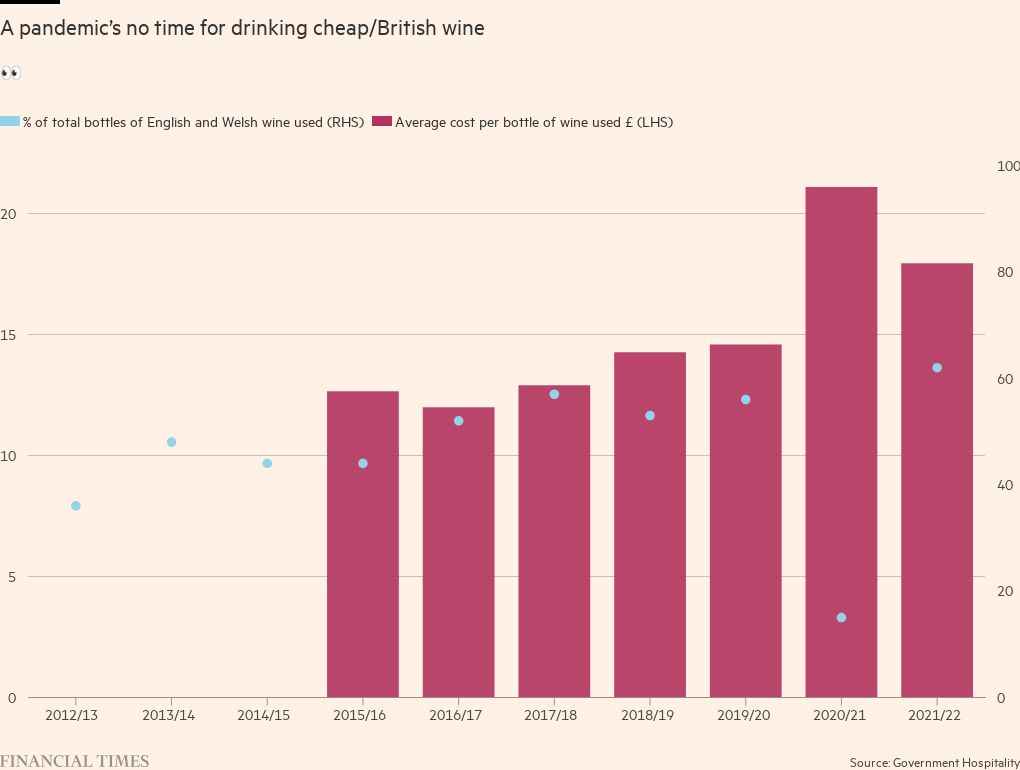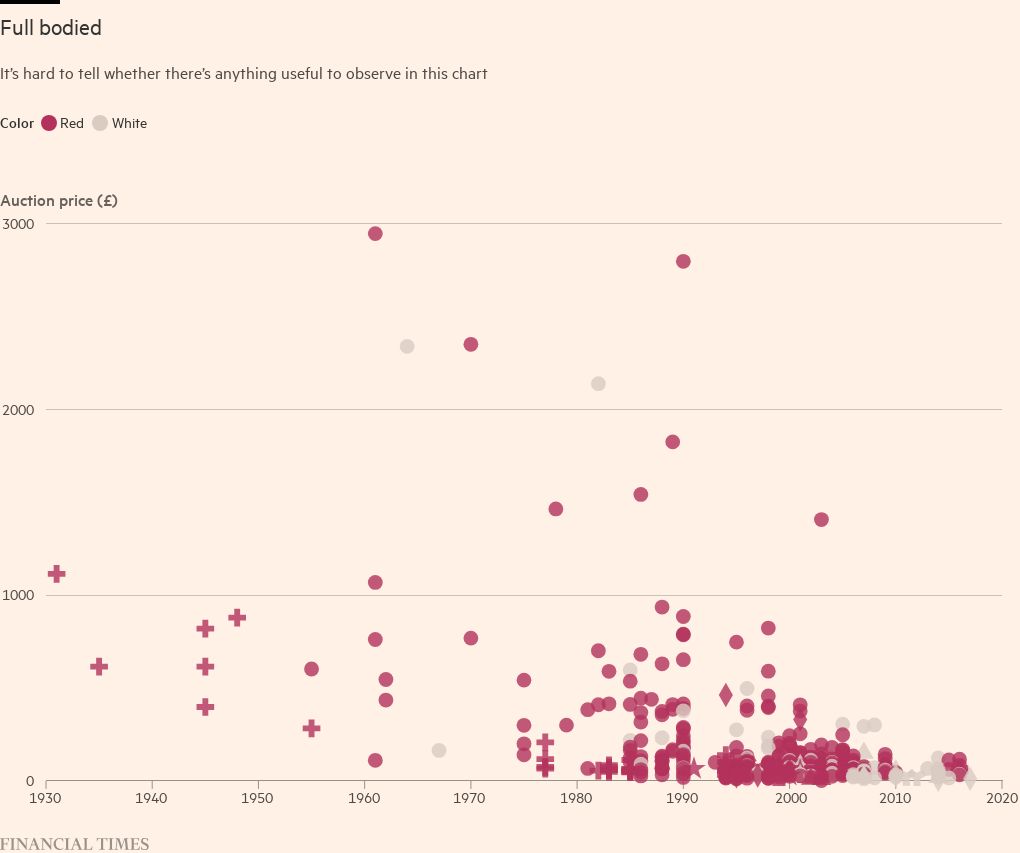A deep dive into the Government’s £3.7mn wine cellar

Roula Khalaf, Editor of the FT, selects her favourite stories in this weekly newsletter.
The government consumed more than 1,400 bottles of wine and spirits at the taxpayer’s expense and topped up its cellar with £27,000 of fresh stock during the two years of the Covid pandemic from 2020 to 2022, new figures show.
The report on the government’s wine cellar was published on Thursday after repeated delays. It showed that 130 bottles were consumed during the year to March 2021, while a further 1,300 were drunk during the year to March 2022.
Yes, the UK has strategic wine reserves.
The Government Hospitality wine cellar, where those figures come from, was established in the aftermath of the First World War to handle buying wine for when the government du jour had high-profile guests.
“The Cellar”, based in the basement of Lancaster House, has had a moderately storied history that involves some looting of the German Embassy and a visit to Warwickshire (potted history here, more colour here).
Its wine choices are guided by the recommendations of the Government Wine Committee, which is chaired by retired diplomat Sir David Wright and includes four masters of wine. Per the bi-annual reports, “The committee has no budget”; more on its work here.
A review launched in the wake of the 2010 election called for the Cellar to be more self-financing, concluding it should make sales of its most expensive wine to pay for more wine.
This appeared to be a great idea, because the GWC has seemingly been really good at buying wine. As of April 2022, the estimated market value of the 32,310-bottle Cellar was £3.66mn, versus a total value at cost of (just) £804,312.
This represented a solid uptick in an already juicy market value:price ratio, suggesting this is one of the few areas where Government procurement creates value for money:
The sales process was going fairly well until the pandemic, with average annual sales over seven years just shy of £50,000, but no wine has been sold since. The latest figures show zero sales for 2020–21 and 2021–22, and a non-encouraging “TBD” for 2019–20.
There are some interesting headline figures…
— consumption fell 96pc year-on-year in 2020–21, to just 130 bottles
— the highest number of bottles used on record (going back to 2012–13) was 5,516, in 2014–15
— Spirit and brandy consumption held up much better during the first year of the pandemic than other categories
— this chart:
…but this is Alphaville, so let’s go beyond the headlines.
Something that’s amazing about the bi-annual Cellar report is its level of detail — delve into the annexes and there’s amazingly detailed information. Like, every-vintage-the-cellar-holds-plus-notes-from-the-GWC detailed:

Take for instance the Château Margaux 1988, a Bordeaux that comes with the following notes:
Keep - 5/93 (1st review) Keep - 9/98 (2nd review) Keep (3rd review) Keep - 6/06 (4th review). Keep - 2/10 (5th review). Use or keep - 7/15. Keep and hope - 5/19
Or Harvey’s Fine Champagne Cognac:
Drink - for “unnamed” occasions only
[The tables are rather lighter in detail on other things in the cellar, such as “gin” and “vodka”, but it’s not called the “gin cellar” so we’ll let it slide, sorry Emma Watson.]
Our reaction to this went something like this:
— wow that’s some great data
— wow that’s a lot of data
— wow we need help
Thankfully, a solution was at hand: with some help from the kind operators of CellarTracker.com, we were able to construct a portfolio that included almost all of the wines listed, along with some sweet, sweet added data.
First of all, for the completionists, these are the bins that weren‘t imported:

And here — using auction data from Wine Market Journal’s quarterly auction trackers, via CellarTracker — are the rest. Appellation aficionados, fill your boots:
By auction value, the most expensive wine held is the (apparently legendary) 1961 Château Latour Grand Vin (though CellarTracker’s community price ranking put the 1964 Krug Champagne Vintage Brut even higher, at £9,038).
We hope that was enjoyable, but let’s be honest: tables are boring.
So how about this?
Prodding that for a while, you’ve hopefully noticed a few things:
— the Cellar is skewed heavily towards French wine, because it’s a wine cellar
— the Cellar is skewed heavily towards red wine, because it’s a wine cellar
— the Cellar’s wine ratings are… remarkably high and stable?
Let’s tackle those in order.
First up, the French connection. Yes, a lot of the wine is from France, and within that, a lot is from Bordeaux or Burgundy. So much, in fact, that it kept spoiling our dataviz. But we didn’t let that stop us:
It’s worth noting that a recent (post-Brexit?) pivot has occurred: in 2021–22, all the wine added to the cellar was English or Welsh.
Second, the colour. There’s not much to say about that except that that is basically how wine works. Government Hospitality buys lot of wine on spec for larger reception events, so most of the white wines it procures — basically glorified alcopops, let’s be honest — never even enter the cellar:
So, thirdly, ratings.
We can see that, yes — based on CellarTracker ratings — the wine is (quantitative analysis via qualitative analysis) good.
CellarTracker uses this rating scale:
Extraordinary (96-100 points)
Outstanding (90-95)
Very Good to Excellent (85-89)
Good (80-84)
Average (75-79)
Below average (70-74)
Avoid (50-70)
Excluding those without ratings, here’s where the Cellar’s bottles land:
This would appear to vindicate the GWC’s hard work — but can one trust the wisdom of crowds?
We weren’t sure, so we asked Jancis Robinson, the FT’s wine correspondent, what she thought of the Cellar’s contents.
Jancis was impressed, and picked out the following as particularly notable (if you’re a foreign dignitary and fancy trying one of these, we recommend emailing in advance)…
— 1961 Château Latour Grand Vin
— 1989 Château Haut-Brion
— 1978 Pétrus
— 1945 Graham Porto Vintage
— 1983 Château Margaux
— 1990 Paul Jaboulet Aîné Hermitage La Chapelle
…she added:
The wines you list are mature classics worth a bomb and I do wonder what quantities they have of them? If several cases, then this must be one of the most valuable wine collections in the UK, but I suspect it may be just a few bottles.
It’s a good point. As mentioned, the Cellar datasets are rather wonderful, but — except in a few instances — they’re bereft of quantities. Sad!
One place where we can observe quantities, however, is in the consumption data (annex A). For instance, we can see that Chapel Down Bacchus 2018 was the most commonly-consumed bottle during 2021–22, with Camel Valley Pinot Noir Rosé 2017 in second. We can also see that, during 2020-21, the ‘pandemic year’, three magnums of Chateau Lynch Bages 1990 (about £200 a bottle) were consumed.
One entry caught our eye:

Quinta do Noval 1931 is no ordinary port. It is, per Decanter, “regarded by some as the Port vintage of the 20th century”. The Government Wine Committee’s notes say “Drink on very special occasions only”. Bottles rarely come to market and price sights vary hugely, from four to five figures. Wine-searcher puts the average at £5,863 excluding tax, while Wine Market Journal says a bottle was last auctioned for £1,115.
So, it’s remarkable that five got sold without any sales being registered. The reasoning is very prosaic, per a Foreign and Commonwealth Office spokesperson:
The transaction spanned two financial years – these bottles were sold in one financial year, but revenue wasn’t received until the following financial year. That financial year will be covered in the next report.
So, uh, SCOOP?!: The Government’s wine-selling dry spell has ended after mandarins drew a £[?]???? bonanza from the sale of five bottles of rare port.
Anyway, we’ve put in a freedom of information request to find out more about the specific quantities in the Cellar, so we’ll return in 20 working days with even more charts!!! Wait, come back…
Further reading
— Buy cheap and sell to rubes: a scientific guide to wine investing
— How much does a pint of lager cost? An Alphaville investigation







Comments